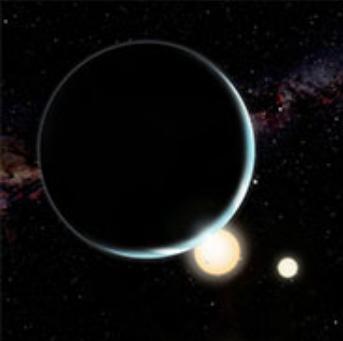[dropcap style=”font-size:100px; color:#992211;”]P[/dropcap]lanets orbiting binary star systems get a bumpy ride.
Gravitational peturbations, destructive collisions and irregular orbits mean ‘the circumbinary disk is a hostile environment even for large, gravitationally strong objects’.
Hardly surprising that the Skywalkers had such a hassle with their harvests.
Luke Skywalker’s home planet Tatooine would have formed far from its current location in the Star Wars universe, a new University of Bristol study into its real world counterparts, observed by the Kepler space telescope, suggests.
Like the fictional Star Wars planet, Kepler-34(AB)b is a circumbinary planet, so-called because its orbit encompasses two stars. There are few environments more extreme than a binary star system in which planet formation can occur. Powerful gravitational perturbations from the two stars on the rocky building blocks of planets lead to destructive collisions that grind down the material. So, how can the presence of such planets be explained?
In research published this week in Astrophysical Journal Letters, Dr. Zoe Leinhardt and colleagues from Bristol’s School of Physics have completed computer simulations of the early stages of planet formation around the binary stars using a sophisticated model that calculates the effect of gravity and physical collisions on and between one million planetary building blocks.
They found that the majority of these planets must have formed much further away from the central binary stars and then migrated to their current location.
Dr. Leinhardt said: “Our simulations show that the circumbinary disk is a hostile environment even for large, gravitationally strong objects. Taking into account data on collisions as well as the physical growth rate of planets, we found that Kepler 34(AB)b would have struggled to grow where we find it now.”
Based on these conclusions for Kepler-34, it seems likely that all of the currently known circumbinary planets have also migrated significantly from their formation locations — with the possible exception of Kepler-47 (AB)c which is further away from the binary stars than any of the other circumbinary planets.”
Stefan Lines, lead author of the study, said: “Circumbinary planets have captured the imagination of many science-fiction writers and film-makers — our research shows just how remarkable such planets are. Understanding more about where they form will assist future exoplanet discovery missions in the hunt for Earth-like planets in binary star systems.”
Source: Bristol University
Image: An artist’s conception of Kepler-34b which orbits a double-star system David A. Aguilar, Harvard-Smithsonian Centre for Astrophysics

Some of the news that we find inspiring, diverting, wrong or so very right.



















